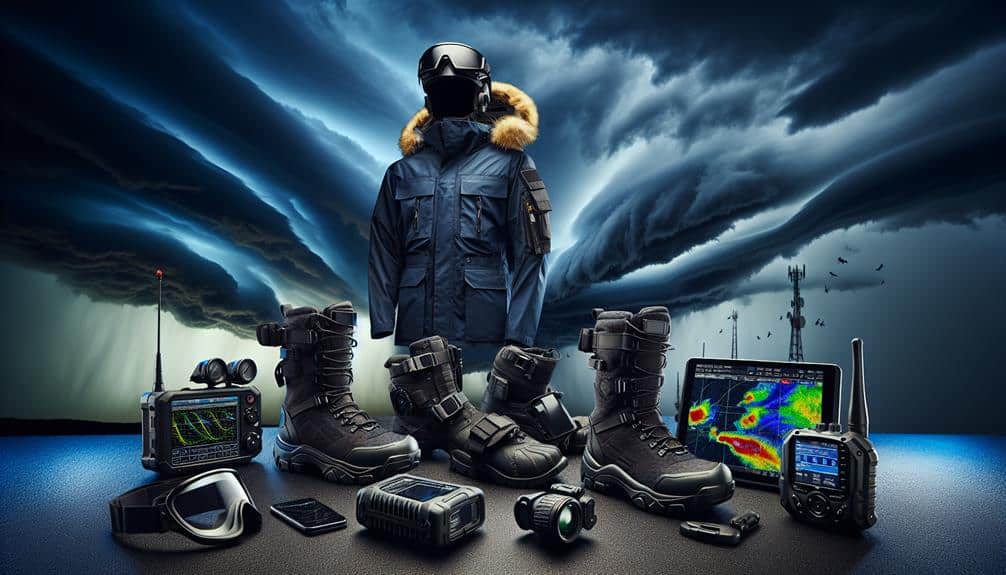Proper gear is vital for us as storm chasers because it guarantees our safety, operational efficiency, and data precision in hazardous environments. We use water-resistant and insulated clothing to protect against extreme weather. Communication devices like satellite phones and GPS trackers keep us connected and allow real-time coordination. Emergency kits with first aid, food, and water purification tools are essential lifelines. Navigation tools like GPS and maps help us track storm paths accurately. Weather instruments provide precise data on wind speed, atmospheric pressure, and humidity levels. By equipping ourselves properly, we can manage the inherent dangers and complexities of storm chasing effectively.
Key Points
- Proper gear ensures safety in extreme weather conditions, reducing the risk of injury or fatality.
- High-quality protective clothing prevents exposure to harsh elements, maintaining body temperature and comfort.
- Advanced communication devices enable real-time coordination and emergency response, crucial for team safety.
- Emergency kits provide essential supplies and first aid, supporting survival during unpredictable weather events.
Protective Clothing
When it comes to protective clothing, we must prioritize materials that are both water-resistant and windproof to guarantee our safety in extreme weather conditions. This dual protection ensures that we remain dry and shielded from the intense winds that storm chasing often entails.
Advanced water-resisting technology is crucial in our gear. Such technology involves coatings and membranes that prevent water penetration while maintaining breathability. This balance keeps us dry without causing overheating, a crucial aspect when we're in the field for extended periods.
Equally important is thermal insulation. High-quality insulation materials, such as synthetic fibers or down, trap heat effectively, providing essential warmth without adding excessive bulk. This feature is indispensable when temperatures plummet, as it allows us to maintain body heat and avoid hypothermia.
Additionally, layering systems that integrate both thermal insulation and water-resisting technology offer versatility, enabling us to adapt to rapidly changing weather conditions.
Communication Devices
Effective communication devices are vital for storm chaser teams to guarantee real-time coordination and safety during volatile weather events. Our ability to stay connected can make the difference between a successful mission and a catastrophic incident.
To achieve this, we rely on a variety of communication tools designed for different scenarios.
Walkie Talkies: These devices are essential for short-range communication within the team. They provide instant voice transmission without the need for cellular networks, ensuring we can coordinate movements efficiently even in remote areas.
Satellite Phones: Unlike standard cell phones, satellite phones maintain connectivity regardless of terrestrial network coverage. This is crucial when tracking storms in isolated regions, allowing us to communicate with emergency services or other teams.
GPS Trackers: These devices help us monitor each team member's location in real-time, ensuring we don't lose track of anyone during the chaos of a storm. They also allow for precise navigation and route planning.
Signal Flares: While not a communication device in the traditional sense, signal flares provide a visual means to indicate distress or location, an essential backup when other devices fail.
Emergency Kits
In addition to robust communication tools, our storm chaser teams must carry thorough emergency kits to handle potential crises effectively. These kits are our lifelines when we're in the field, facing unpredictable and often dangerous weather conditions. They contain survival essentials designed to guarantee our safety and well-being during emergencies.
First and foremost, each kit includes a detailed first aid package. This isn't just a simple collection of bandages; it's equipped with items for treating minor injuries, stabilizing fractures, and managing more severe trauma until professional medical help can be reached.
Additionally, we stock our emergency kits with food supplies that are non-perishable and nutrient-dense. These items sustain our energy levels during prolonged operations.
Coupled with this, water purification tools are essential. Access to potable water can't be guaranteed in storm-affected areas, so having the means to purify water on-site is vital for preventing dehydration and maintaining our health.
Reliable direction tools are essential for storm chaser teams to accurately track and predict storm paths. When we're out in the field, the ability to navigate quickly and precisely can mean the difference between capturing critical data and missing the storm entirely.
Our approach to direction combines several key tools and techniques.
- GPS Tracking: Utilizing GPS tracking allows us to pinpoint our exact location in real-time. This technology enables dynamic route adjustments based on the storm's movement, ensuring we stay within safe proximity to the storm.
- Compass and Map Orientation: While digital tools are invaluable, a traditional compass and map orientation remain vital. These tools provide a reliable backup, especially in situations where electronic devices might fail due to harsh weather conditions.
- Topographical Maps: Having access to detailed topographical maps helps us understand the terrain we'll be moving through. This knowledge is essential for identifying potential obstacles and planning our routes effectively.
- Mobile Navigation Apps: Advanced mobile apps offer layered data, integrating weather patterns with geographical information. These apps enhance our situational awareness by providing real-time updates and predictive path modeling.
Weather Instruments

To accurately measure and analyze storm conditions, we rely on a suite of specialized weather instruments designed for real-time data collection. Using these tools, we achieve high data accuracy, which is important for both our safety and the efficiency of our operations. Our primary instruments include anemometers for wind speed, barometers for atmospheric pressure, and hygrometers for humidity levels. Each device is meticulously calibrated to make sure the utmost precision in our readings.
By deploying these instruments, we enhance our forecasting accuracy. Real-time data from Doppler radar systems and weather satellites allows us to track storm movements and intensities with remarkable precision. Mobile weather stations equipped with GPS provide localized meteorological data, giving us an edge in rapidly changing conditions.
Efficiency is another important factor. The quicker we can gather and interpret data, the faster we can make informed decisions. This not only improves our response times but also maximizes our safety. High-resolution cameras and thermal imaging tools supplement our data, offering visual confirmation of storm dynamics.
Frequently Asked Questions
How Do Storm Chasers Ensure Vehicle Safety During Extreme Weather Conditions?
We guarantee vehicle safety during extreme weather conditions through rigorous vehicle maintenance, safety checks, and adherence to emergency protocols. Constant communication within the team allows us to navigate and respond effectively to rapidly changing situations.
What Training Is Required for a Storm Chaser to Operate Safely?
We undergo rigorous training in safety protocols and equipment maintenance. This guarantees we can operate safely during extreme weather. By mastering these skills, we maximize our freedom to chase storms while minimizing risks and guaranteeing team safety.
How Do Storm Chasers Fund Their Expeditions?
We rely on various fundraising strategies and sponsorship opportunities to secure essential funds. Effective budget planning is vital to manage equipment costs and guarantee successful expeditions. Balancing these factors allows us to operate efficiently and independently.
What Role Does Teamwork Play in Successful Storm Chasing?
Imagine a finely tuned orchestra. Teamwork in storm chasing hinges on communication and coordination. Like musicians, we execute strategy and planning precisely, ensuring our safety and data collection, all while embracing the freedom to explore nature's fury.
How Do Storm Chasers Handle Encounters With Wildlife During Their Missions?
When we handle wildlife encounters during missions, we prioritize safety measures to guarantee both our protection and the animals'. We maintain a respectful distance, use non-invasive observation techniques, and stay alert to avoid unexpected interactions.


